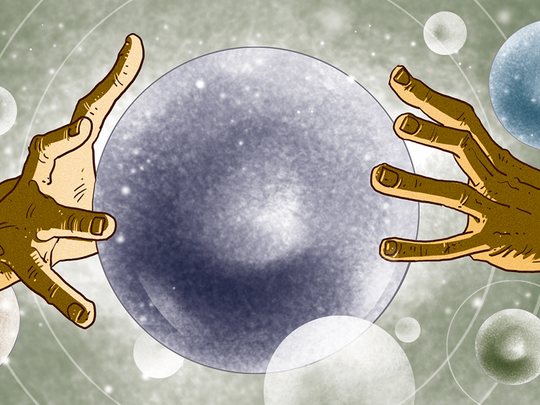
A famous quip goes something like this: “Predictions are very difficult to make, especially about the future.”
It is attributed to a number of people, including the great 20th century Danish physicist Niels Bohr, the father of the modern atomic theory and winner of the Nobel Prize in 1922. Indeed, in a landmark and now very famous study published in 2005, Philip Tetlock, professor of Psychology and Political Science at the University of Pennsylvania, reviewed the predictions of experts on a large number of topics and showed that in retrospect, they had no ability to forecast events better than the average person on the street.
A week ago, just as I was finishing this piece, came one stunning scientific surprise: The “discovery” — at least by calculation — of a ninth planet in our solar system, a planet 10 times bigger than Earth and 600 times farther from the Sun. The inference of the existence of such a planet (and its characteristics) was based on the effects that were observed on several objects at the outskirts of the solar system; the same way that Neptune had been predicted and then observed and Pluto had been predicted and then observed, from their effects on their neighbours.
Sometimes reality surprises us by overtaking our forecasts: Most physicists were hoping that gravitational waves, long predicted by Einstein’s theories but never detected in several decades of attempts, would be detected this year with the launch of the international Advanced-LIGO (Laser Interferometry Gravitational Wave Observatory), or at least as soon as its complementary facility, the Virgo interferometer in Italy, begins operating, but very strong rumours of positive and historic detection have circulated in the last few weeks, for which we await confirmation.
So there is no doubt that scientific surprises happen now and then. Still, in science, we can also predict some future events and developments, much better than can be done in, say, politics, economics, or other fields of human activity. Why is that?
Well, first, space events in particular are predictable, in fact many years ahead of time, because they follow well-understood laws of nature. Secondly, some developments in other fields of science follow recent breakthroughs, and one can thus project forward and outline the expected progress in that field.
So let me make some safe scientific predictions for 2016, starting with space events — those are the really easy ones.
On March 9, there will be a solar eclipse. It will be seen as a total eclipse from Indonesia to Japan (roughly) and as a partial eclipse in some regions near there. On the “path of totality” (the sun being totally eclipsed, producing total darkness), it will last four minutes and 10 seconds. You see, we can model the motions of the moon, the earth, and the sun (and other nearby and relevant celestial bodies) precisely enough to have the computer determine for us when and where alignments will occur. Eclipses are some of the easiest events to predict — and perhaps the most spectacular as well.
On May 30, Mars will be closest to Earth, and hence for about two weeks around that date, Mars will be shining bright and red. In fact, it will be twice brighter than Sirius, the brightest star in the night sky. But there will be none of that nonsense “two moons in the sky” rumour that spreads through social media every time Mars gets close. However, that closeness is an opportunity to send a spacecraft to the red planet (taking no more than seven months to reach there), and the Europeans will do that with ExoMars, which will launch in March and arrive in October, to study some aspects of the atmosphere of Mars and land a rover in a new, revolutionary way. (That same situation will be taken advantage of by the UAE’s Hope mission to Mars in July 2020.)
There are also some other spacecrafts that have important dates in 2016: Juno will reach Jupiter on July 4, 2016, and Rosetta will crash itself on Comet Chury in September, to draw one last bunch of scientific information ...
Science is not all space and physics, of course. There are other momentous developments in other fields. I must highlight, in particular, the recent development of the CRISPR (Clustered regularly-interspaced short palindromic repeats) genome-editing technique, hailed as the most important scientific breakthrough in 2015, and which promises to revolutionise genetics and its applications.
Indeed, Chinese researchers announced that they used CRISPR to modify human-embryo genes (with a number of errors), and a summit was held last December to discuss the ramifications of this easy and cheap technique and to try to agree on a set of principles on how it should used — lest we start creating monsters (viruses, animals, and humans).
But the positive and useful applications of CRISPR cannot be ignored, not to mention its commercial benefits, and some private firms have already announced that they will be implementing it to try to remove or “turn off” the gene for haemophilia, which affects about a million people worldwide and impacts their lives quite severely in many cases. Other applications include the editing of gene that prevent (resist or react to) some treatments of cancer and other serious diseases. There is no doubt that this can be a potent new technique, but without rigorous guidelines, it can easily deviate and take a dangerous tangent.
As science progresses and opens up new venues, amazing developments occur each year. Scientific events of 2016 promise to be exciting and fascinating.
Nidhal Guessoum is a professor at the American University of Sharjah. You can follow him on Twitter at: www.twitter.com/@NidhalGuessoum.










